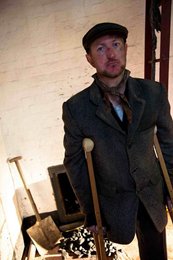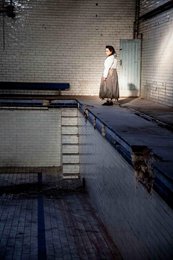The Baths is the third show in Louise Lowe's collaboration with Prime Cut Productions, the other two being Demeter: Still Life Still and Right Here Right Now. It is based in the Victorian Templemore Baths which opened in 1893 to serve the densely populated terraced streets of East Belfast, near Harland and Wolff and the Ropeworks. The workers' homes normally only had an outside toilet, so the Baths provided hygienic bathing facilities for the families in the area. The Baths also had a swimming pool and generations of local children learned to swim there. The Baths still has a pool – though the original one is no longer in use – and a small gym, but the bathing facilities are in a part of the building that is now closed to the public.
The piece, like Lowe's Dublin works Laundry and World's End Lane, brings the spectators into the building in groups of three and then separates them so that the spectator is alone with the actors in each scene. The performance opens in the reception to the modern pool, where a young girl sits slumped on a bench, refusing to leave, and an older woman chats about her enjoyment of swimming. It is not immediately clear whether the performance has begun: the woman could simply be passing the time and the girl attempts to draw the waiting spectators into her telephone fight with her mother. The spectator is called away from the reception area by a woman with a bucket, who abruptly emerges from a disused part of the building to call each in turn into the bathing rooms.  This ambivalence or uncertainty about who is performing and who is just a passer-by is an intriguing quality of Lowe’s work, creating a very particular kind of audience experience. The scripting is improvised to allow the performers to respond to different degrees of interaction from the spectators.
This ambivalence or uncertainty about who is performing and who is just a passer-by is an intriguing quality of Lowe’s work, creating a very particular kind of audience experience. The scripting is improvised to allow the performers to respond to different degrees of interaction from the spectators.
The piece brings together two times: 1912 and 2012. These contemporary characters speak about the performance and the rehearsals they’ve seen, and the benefits they hope will come from raising the profile of the Baths, and they discuss the health benefits of swimming and its liberating effects. The present day scenes are interwoven with the historic, functioning also to provide background information at key moments. In one segment, a performer posing as a modern-day employee tells how the Baths were a morgue during the Blitz, and that they are haunted by a young woman looking for her lover. The spectator then enters the disused sections of the building to encounter the ghosts.
Most of the scenes take the spectator back in time to offer brief glimpses of major historical events. In the washrooms, there is a man who is building the Titanic and who explains the process of sealing the wooden decks. In a disused corridor the ghost of a mother and child, drowned on the Titanic, whisper and rustle and lead the spectator to another haunted scene. The women in the laundry-room shout and jostle the spectator, demanding he or she write a letter to Dora Montefiore offering to bring the starving children of the Dublin strikers to Belfast, evoking a whole historical episode in a few brief moments.
 The design of the work is unobtrusive, using natural lighting and sound where possible and blending the everyday lighting and soundscape of the public building with the theatrical design of the scenes from the past. Ciaran Bagnall and Carl Kennedy work effectively to create the other-worldly effects of the ghostly Titanic’s corridor, or the ghosts of those killed in the Blitz as they seek each other desperately through the projections and sounds of the evoked watery space. In contrast, the laundry room is warmly lit and, despite its evident hardship, is a welcoming space; while the cold evening light coming through the skylights of the bathing rooms draws the spectators’ attention to the austerity of the workers’ lives.
The design of the work is unobtrusive, using natural lighting and sound where possible and blending the everyday lighting and soundscape of the public building with the theatrical design of the scenes from the past. Ciaran Bagnall and Carl Kennedy work effectively to create the other-worldly effects of the ghostly Titanic’s corridor, or the ghosts of those killed in the Blitz as they seek each other desperately through the projections and sounds of the evoked watery space. In contrast, the laundry room is warmly lit and, despite its evident hardship, is a welcoming space; while the cold evening light coming through the skylights of the bathing rooms draws the spectators’ attention to the austerity of the workers’ lives.
The Baths is a warm and often funny piece of work that draws in a proportion of its audience from the local community and from the pool’s present-day customers, and their familiarity with the space helps to create a playful atmosphere. At the end of the performance the spectators are offered coffee and can compare their letters to Lady Montefiore and talk about their experience as they moved through the performance, which allows us to compare notes on our different responses and interpretations; the pleasure of local audience members comes through clearly in these conversations. This project by Prime Cut offers a moving and evocative way to celebrate a community and a history.
Lisa Fitzpatrick teaches drama at the University of Ulster.